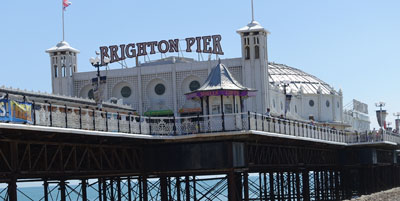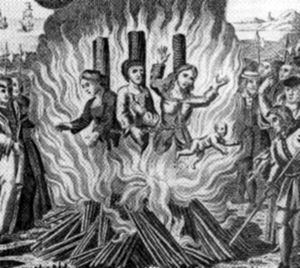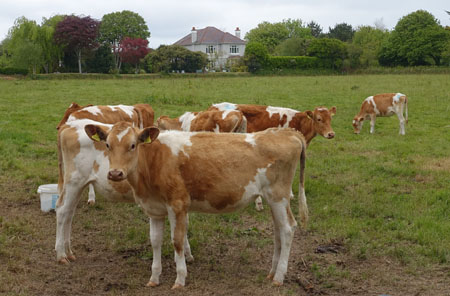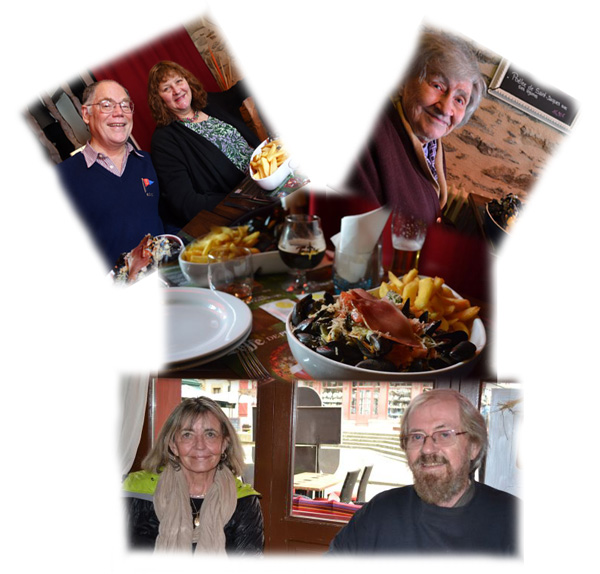
Another spring and another trip to Guernsey; we’ve lost track of the number of times we’ve been there. What started off years ago as a new and exciting adventure has become a return to the familiar and comfortable, much like one feels with a week at the cottage. This time we decided to break the time up with 5 days in Brittany in the middle.
 It began with the flight from Toronto to Gatwick with a four hour layover before the final short hop to Guernsey. This time we decided to fill the waiting time with a quick side trip by train to Brighton Beach for lunch. It’s a pretty holiday town with its Victorian pier but it’s not on our ‘must go back’ list.
It began with the flight from Toronto to Gatwick with a four hour layover before the final short hop to Guernsey. This time we decided to fill the waiting time with a quick side trip by train to Brighton Beach for lunch. It’s a pretty holiday town with its Victorian pier but it’s not on our ‘must go back’ list.
Once in Guernsey, it was a short taxi ride to our favourite country inn, La Barbarie Hotel in St Martins.
Because we have travelled so often to Guernsey, George has written an article to answer the now frequently asked question: "Why Guernsey?" (insert link to the mag. article) He'd mentioned La Barbarie Hotel in it so we gave a copy to the manager Andrew Coleman. During our stay, copies were also passed on to Mike Hopkins at the Tourist Bureau, our friends at Priaulx Library, Davina, the owner of the St. George's B&B, and the manager at La Nautique - still our favourite restaurant in St. Peter Port.
Our first Four Days in Guernsey were "a return to the familiar." No longer did we feel like tourists, bustling to see the sights. Rather, our plan was simply - To Be not To Do -to wander the streets and paths of the island that was ‘home’ to George’s ancestors, to savour the towns and villages, and to enjoy the life that modern Guernsey has to offer. Granted, we did drop in to the Priaulx Library to see if there was anything more that could be found – an old habit and one that never fails to “pay off” and keep us inspired to keep searching.
 One afternoon, we walked the area of Tower Hill where G’s gr3 grandmother Margerite Loney, a poor manteaux maker, had (in 1830-65) lived and raised two sons. Her home, an odd shaped building at 10 Tower Hill was in the poor, workers’ area of town, once the site of executions and witch burnings, hence the reference to the Tower of London
One afternoon, we walked the area of Tower Hill where G’s gr3 grandmother Margerite Loney, a poor manteaux maker, had (in 1830-65) lived and raised two sons. Her home, an odd shaped building at 10 Tower Hill was in the poor, workers’ area of town, once the site of executions and witch burnings, hence the reference to the Tower of London
This area of the old town is arranged higgledy-piggledy up a steep hill, with narrow flights of steps between streets, and it is rumoured that some of the flights are haunted by those witches who met their end in the flames. During the witch craze that swept Europe in the 16th and 17th centuries, 103 people were found guilty of witchcraft on Guernsey alone.
flights of steps between streets, and it is rumoured that some of the flights are haunted by those witches who met their end in the flames. During the witch craze that swept Europe in the 16th and 17th centuries, 103 people were found guilty of witchcraft on Guernsey alone.
Among them were three women brought to court on charges that their religious views were contrary to those required by the church authorities. They were found guilty of heresy by an Ecclesiastical court and condemned to death. The execution, was carried out on Tower Hill on or around 18 July 1556, when all three were burnt on the same fire. They ought to have (by law) been strangled beforehand, but the rope broke before they died and they were thrown into the fire alive.
The last witchcraft trial took place in 1914. The accused, Mrs. Lake, was eventually convicted of disorderly conduct and sentenced to only 8 days – times had changed. More
Another day and another walk further up the hill from Tower Hill, took us past Victor Hugo’s “Hauteville” house, to Rue Havelet, where, at number 4, Peter De Putron had lived. He is of interest as his body was interred, for some unknown reason, in Candie cemetery, on top of Margerite in 1907, 40 years after her death. Interestingly, Margarite’s burial cost 1 shilling while Peter’s was 8 shillings – inflation of the times?
And another search took us on an ‘ancestral walk’ from SPP, out Bordage Street past where William Loney (gr2father) had worked as a cabinet maker, and along Ruette Bray, still somewhat rural, where George Parson (gr2father), a farmer /butcher had lived. We walked all the way to St Martins; a route they would have travelled often to get their meat to market in town.
Aside from these adventures into the past, out time was more present day focused, a few of the memorable moments being:
Strolling by the ancient farmhouse where George’s grandfather had been born and being invited in to chat once again with the current owner, Tony, who had just happened to be out on his front lawn and greeted us as he would a neighbour. This was a brief catch-up on life visit and we look forward to the next; a trip to Guernsey wouldn’t be the same without these casual encounters with Tony and these peeks into the ancestral home.
We tend to meet up each trip back now also with Roger, a previous owner of the farmhouse who now lives in another ancient farmhouse just down the road. Roger is fascinated with, and very knowledgeable about, Guernsey history we so we always learn. A current interest of his is ancient artesian wells so he gave of a “quick lesson” and a tour of the wells on his property.
A walk along the rugged coast of Petit Bot Bay, where pirates dropped anchor several centuries ago, brought us to this tranquil scene and, wandering back to our hotel along lanes between fields, we came upon Guernsey cattle who politely paused from grazing to glance our way.


We’d planned this trip for just after the Liberation Day festivities, and regretting somewhat having missed them this time, were pleased to discover that a “Liberation Jazz Concert” was scheduled for May 16 in the auditorium of the Tapestry Museum in St. Peter Port. It was billed as a cabaret style event with music from the 1940’s performed by the local youth jazz band and the Guernsey Girls Choir. So, we headed into town for the evening which turned out to be very much a local thing – with surprisingly good music.
While sitting in a café across from the old Guernsey Market (where several of G’s ancestors had, as butchers, sold their meat), Tana read in the local paper that Guernsey Post had just issued a special stamp to commemorate the 175th anniversary of “the penny black”, the world’s first adhesive stamp used in the public postal system. It had been mailed from Guernsey. Given our recent interest in the history of the postal system and the number of old postcards in out attic, we went in search of one to bring home as “a souvenir.”
BRITTANY
After four days in Guernsey, it was time to fly to Dinard in Brittany. Aurigney offers a commercial flight once or twice a day in a very small plane, flying at 3000 feet above the channel.

Our time in Brittany ranged from okay to very good. Vannes was a disappointment with not much to see or do in our 1 1/2 days there. Quiburon and Concarnou were much nicer and our favourite was Dinan.
But first, it was off to Rohan in the Morbihan region for a dinner of traditional galettes (the main course version of ‘Crepe Bretagne’) and the night at Villa Tranquille,a B&B that looks like it belongs on the set of
“Rocky Horror Picture Show.”
At one time Rohan was the home of the House of Rohan, members of which included viscounts, dukes and princes and has had a prominent role in French history. Now it is a sleepy agricultural village of 1500.

The next morning it was off to nearby Josselin with its castle where we met George’s cousin Lynda Cookson for lunch of mussels and local beer. George had met her several years earlier when she and Alan, her husband, were living in Galway, Ireland. Lunch was pleasant and conversation easy and, afterwards, we headed for a brief (far too brief) visit to their new home in Brittany - a centuries old farmhouse that we regret not having taken some pictures of...maybe next time?

And then it was off to Vannes for two nights in the hotel "La Marébaudière," described as a large Breton-style house/hotel in the town centre. We arrived at rush hour (not a good idea) to discover that directions were non-existent and, by the time we finally found our hotel tucked away on an unsigned street, were frustrated and weary. The hotel was fine, the harbour on the Bay of Biscay in northwest France, was pretty but the town had little to offer beyond its traffic
The next stop was Quiberon (Breton: Kiberen) situated on the Quiberon peninsula north of Vannes, primarily known as a seaside resort for French tourists during the summer. It was still spring and we were Canadian travellers but the town was pleasant enough so we stayed for the night.
That afternoon we visited Carnac where more than 3,000 prehistoric standing-stones, hewn from local rock, were erected by pre/proto-Celtic people of Brittany: the largest such collection in the world. But, to be honest, they looked like abandoned building blocks set out in rows.
Next day it was off to Dinan via the town of Concarneau with its walled town on a long island in the centre of the harbour. “Historically, the old town was a centre of shipbuilding. The Ville Close is now devoted to tourism with many restaurants and shops aimed at tourists. However restraint has been shown in resisting the worst excesses of souvenir shops.” Needless to say, our visit was brief giving time for lunch and then leaving, heading east towards Dinan, close to the airport where we needed to be the next day.
Much to our surprise, Dinan, was lovely. It is a walled, medieval Breton town with many fine old buildings such as the Basilica dating from the 13th century. Down the steep hillside from the town is the River Rance and the quaint port of Dinan.
From there the next day, we had an unexpected adventure. For time convenience, we had chosen to fly over and back with Aurginy from SPP to Dinard. Going back, we arrived at the airport at 2pm for our 3pm flight only to discover that it had been canceled due to fog in Guernsey. There were no other flights scheduled for the day (it is a very small airport), so we took a cab to St Malo, waited 3 hour (time for lunch) for the ferry. But the only ferry that day went to Jersey where we had drinks and snacks for 4 hours waiting for another ferry to Guernsey. It was late by an hour but finally we got to our hotel at 1 am. St Georges, our traditional hotel, was already full when we came to make reservations so we had decided to upscale our stay at Moores Hotel on Le Pollet in the heart of SPP. Fortunately, they have 24 hour porter service, so it was still open when we arrived.
Our final 2 days in Guernsey
The Moores Hotel was a great find - excellent location, lovely room, cordial service, and a relaxing terrace bar.
It was pleasant to be in the heart of the old town and we just enjoyed being there.
A few highlights of our final 2 days in Guernsey were:
A lovely dinner at La Nautique - sensational food as usual!
A band concert on the lawn which we listened to from a bench right next to the magnificent Victor Hugo Statue.
An evensong service at Town Church - as always a lovely experience but this time somewhat muted by the absence of Steve Foote's father who had died the previous year. (We have yet to meet Steve who lives in England and shares some of George's family roots and whose research on butchers in Guernsey is a source to be drawn on for one of George's upcoming magazine articles.)
A couple of stops for drinks and snacks at the Moore's Terrace Bar. We came to enjoy lingering there, looking up at the huge mural that depicts famous Guernsey characters, including historical figures such as Isaac Brock and Victor Hugo, and Admiral George Saumarez, standing on a balcony above.

On our final afternoon in Guernsey, Tana wrote out a postcard which she mailed home to us. With sending postcards becoming a thing of the past, it had seemed a good idea and, also, something to add to our postcard collection. The message she wrote on the back was:
" In our room here at Moore's Central Hotel in St. Peter Port there's an Internet sign that says: "Not even Nana wants a postcard anymore."
Before leaving home I'd come across a quote in a vintage postcard magazine that went something like "You send a text or email to share information but you send a postcard to share an emotion" or, perhaps more accurately, a reaction or experience.
We'll be home before this postcard gets delivered but right now, as I write it, we're in Guernsey drinking Pimm's on the Terrace of our hotel."
This conveys much of what being in Guernsey means to us and of the sense of looking backward in time to appreciate another era it brings. The picture on the front, a photo of an original watercolour of a Guernsey Farmhouse, conveys much of that same hauntingly peaceful feeling.
I
Back to Travel Index
Back to HOME page
78 Mountain Ave, Hamilton, Ontario, Canada L8P4G2
All text and images are copyrighted. Any use is by permission only.
Site is under construction. Last update:
July 19, 2015